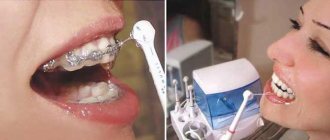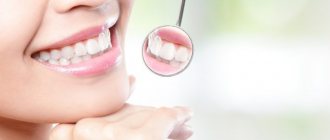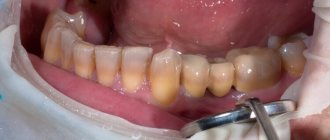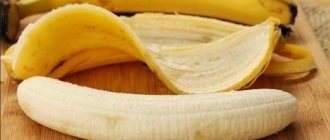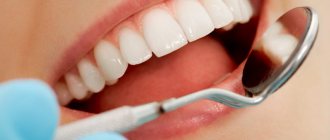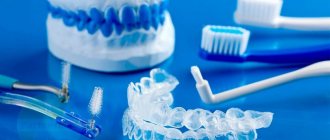Benefits of tea for teeth
Our ancestors believed that green tea contains many healing properties. Maintaining a healthy immune system, cheerfulness or calmness, as well as treating a fairly decent list of diseases.
In search of an answer to the question “what effect does green tea have on tooth enamel, gums and oral cavity?” In the 20th century, scientists conducted a large-scale experiment. 200 absolutely healthy Indians became voluntary participants in the experiment. For 3 years, the focus group drank the drink daily. Scientists regularly checked and studied the condition of the subjects' oral cavity.
The results of the experiment clearly indicate that the subjects visited dental clinics much less often than those who do not consume green tea daily. The thing is that this drink contains a significant amount of fluoride, which is responsible for dental health.
Green tea
One cup of this drink contains an average of 0.3 mg of fluoride, which effectively fights caries, strengthens dentin and tooth enamel, and maintains its whiteness.
They are not at all as safe as advertising would have us believe! They contain a high percentage of acids (citric and phosphoric), which affect tooth enamel, leaching calcium, fluorine, potassium, magnesium and other necessary substances from them. The process of leaching mineral components from enamel is called demineralization. Drinking wine has the same effect on teeth, although alcohol increases the rate of adverse effects several times. Wine contains a whole range of acids (tartaric, lactic, maleic and citric). This is why it is recommended to serve cheese with wine: they at least minimally neutralize the attack of acids. In a word, French gourmets knew what they were doing when they compiled long lists of cheeses that were supposed to be served with this or that wine.
By drinking three cups of drink a day, we provide the necessary dose of fluoride and supply the body with polyphenols - substances with powerful antibacterial properties.
Harm of tea to teeth
Despite the high fluoride content, not every tea is equally beneficial. Black tea, beloved by millions, especially when it comes to low-quality raw materials, stains tooth enamel in an unflattering color. After daily long-term consumption of this drink, plaque appears on the teeth, then they turn yellow from the tea, and ultimately the teeth darken.
Black tea stains teeth almost the same way as an equally popular drink - coffee. However, contrary to the assumption that is obvious at first glance, coffee has a more gentle effect on tooth enamel than Indian coffee. Therefore, to the question “what is more harmful to teeth, tea or coffee?”, the answer will be unequivocal - tea.
To avoid the harmful effects of the Indian drink, after drinking it, you should brush your mouth and rinse with a specialized solution. However, you should not use a solution based on chlorhexidine, which only enhances pigmentation.
Sugar, which people with a sweet tooth love so much, also negatively affects the condition of the oral cavity. Sweets and other “goodies” with the addition of sucrose destroy enamel and contribute to the development of unpleasant diseases such as caries or periodontal disease.
Therefore, before you pour yourself a cup of invigorating drink, think about safety measures. Morning tea drinking should be done before brushing your teeth, and you should also not forget about evening oral hygiene.
Is green tea harmful to teeth?
It has long been known that many products have a coloring effect. This is due to the presence of strong natural pigments in their composition. Such products include, for example, berries of red, blue and similar colors, as well as all kinds of drinks made from them - including wine and juices. Some products can also be colored, but not only due to the pigments they contain.
Not long ago, a group of Indian scientists specializing in dentistry practically outlawed green tea. In their opinion, despite the high content of nutrients and antioxidants that prevent aging, green tea is harmful to teeth. The fact is that it not only stains the enamel, but also - as researchers led by Dr. Karishma Yaradi convince us - increases the level of acidity in the oral cavity, thereby increasing the porosity of the enamel. And this already leads to the penetration of coloring elements deeper.
However, is green tea really such an insidious enemy as respected scientists from India tell us? Firstly, the coloring effect of green tea should not be exaggerated: in order for your teeth to really noticeably turn yellow, you need to drink at least three cups of strong infusion a day. Secondly, as Andrei Anatolyevich Lavrov, the chief physician of the Swiss dentistry Swiss Smile, rightly notes, there is no need to demonize this wonderful and healthy drink in all respects; instead, you should focus on the more terrible enemies of a beautiful smile, for example, Coca-Cola and cigarettes .
Dr. Marufdi, a dental therapist at Stolitsa Dentistry, agrees with his colleague, recalling that in addition to antioxidants, green tea also contains many other beneficial microelements, such as calcium and magnesium, which are very important for teeth.
In any case, all experts - both Russian and Indian - agree on one thing: of course, you shouldn’t completely give up drinking green tea. But limiting yourself to two cups a day is the right decision. And a minor staining effect, which does not appear immediately, can be dealt with by regular professional oral hygiene, which should be done at least twice a year, regardless of whether you are a heavy smoker, a tea drinker, or do not abuse coloring products at all.
It has long been known that many products have a coloring effect. This is due to the presence of strong natural pigments in their composition. Such products include, for example, berries of red, blue and similar colors, as well as all kinds of drinks made from them - including wine and juices. Some products can also be colored, but not only due to the pigments they contain.
Not long ago, a group of Indian scientists specializing in dentistry practically outlawed green tea. In their opinion, despite the high content of nutrients and antioxidants that prevent aging, green tea is harmful to teeth. The fact is that it not only stains the enamel, but also - as researchers led by Dr. Karishma Yaradi convince us
– increases the level of acidity in the oral cavity, thereby increasing the porosity of the enamel. And this already leads to the penetration of coloring elements deeper.
However, is green tea really such an insidious enemy as respected scientists from India tell us? Firstly, the coloring effect of green tea should not be exaggerated: in order for your teeth to really noticeably turn yellow, you need to drink at least three cups of strong infusion a day. Secondly, as Andrei Anatolyevich Lavrov, chief physician of the Swiss dentistry Swiss Smile, rightly notes, there is no need to demonize this wonderful and healthy drink in all respects; instead, you should focus on the more terrible enemies of a beautiful smile, for example, Coca-Cola and cigarettes .
Dr. Marufdi, dental therapist at Stolitsa Dentistry, agrees with his colleague, recalling that in addition to antioxidants, green tea also contains many other beneficial microelements, such as calcium and magnesium, which are very important for teeth.
In any case, all experts - both Russian and Indian - agree on one thing: of course, you shouldn’t completely give up drinking green tea. But limiting yourself to two cups a day is the right decision. And a minor staining effect, which does not appear immediately, can be dealt with by regular professional oral hygiene, which should be done at least twice a year, regardless of whether you are a heavy smoker, a tea drinker, or do not abuse coloring products at all.
The ancient Chinese Tang Dynasty gave the world a unique drink created by boiling tea tree leaves in hot water.
For more than 5,000 years, tea has been not only an indispensable drink for many peoples, but also expands its composition thanks to additional aromatic ingredients. The most common varieties are black and green tea.
We suggest you familiarize yourself with: There is a yellow-green coating on the tongue
Black
Black tea contains theotanin, a substance that has a bactericidal effect. Once in the oral cavity, the liquid eliminates harmful bacteria and microorganisms, counteracting the development of caries or slowing down its growth. Theotanin components slow down the growth and reproduction of bacteria in dental plaque and promote easy cleansing of the oral cavity.
Drinking a cup of black tea after a meal will have a positive effect on the cleanliness and health of your teeth.
It is recommended to drink liquid 20 - 30 minutes after eating for proper functioning of the gastrointestinal tract.
Is it possible to have tea...
Often a similar question arises after the following situations:
- removal of a tooth;
- whitening;
- filling (installation of a seal);
- eruption
...after teeth extraction
Dentists warn that after you have a tooth removed, it is not recommended to drink or eat for 2-3 hours. If it is important for you to know the exact time, then the doctor is unlikely to help you in this situation. After all, every person is unique. And the formation of a blood clot in the hole directly depends on the coagulability of your blood.
Hot or even warm liquid negatively affects blood clotting. But this does not mean that after the specified time has passed, you should immediately brew some tea. At first, you should drink exclusively cold tea, which contains tannic acid, which has a beneficial effect on the healing process.
...after teeth whitening
To maintain the effect of whitening for a longer period, experts recommend a “white” diet. Any coloring food (including liquids) negates the effect of the procedure quite quickly. Therefore, if you value your money, you should not consume black tea, it is better to use green or white. But these varieties should also be included in your diet after 2 weeks in a limited amount.
...after filling
After installing the filling, it is not recommended to drink or eat for 2 hours. And in the first few days, in order to avoid staining the filling material, you should not drink a black drink, and it is better to drink green and white the next day.
...during teething
The tea drink does not have much effect on teething. Although green tea sometimes helps to soothe aching gums.
Prevention of dental and gum diseases with herbs
In order to never visit a dental office, at least for treatment, you need to take care of your health from childhood, every day.
Set of preventive measures:
- brush your teeth at least 2 times a day (cleaning before bed is especially important, because it is at night that bacteria multiply and accumulate in the mouth during the day);
- rinse your teeth (you can even use herbal tea, you don’t have to buy expensive products in supermarkets);
- eat right, food should be rich in vitamins and minerals, especially calcium and fluorine;
- get rid of plaque and tartar in a timely manner;
- prevent bleeding and gum inflammation;
- strengthening teeth and gums.
What herbs are suitable for rinsing:
- 1. Oak bark, chamomile, calendula, St. John's wort, rosemary, sage, calamus will save you from inflammation and bleeding. These plants have anti-inflammatory, anesthetic, wound-healing and astringent effects.
- 2. Herbs for teething – chamomile and sage. They contain natural substances against swelling and swelling that accompany tooth eruption. Tincture of calendula and propolis also helps well.
- 3. After tooth extraction, what herbs to rinse with: eucalyptus, golden mustache, as well as a collection of chamomile flowers, oak bark, St. John's wort and sage. Medicinal plants should be used until the wound heals.
Treatment of teeth and gums with herbs
Dental treatment can cost a pretty penny, especially if the situation is advanced. Therefore, before consulting a doctor, you can try effective folk remedies that have excellent reviews.
Listen to Maria Pushkina’s 7-minute review from the city of Ryazan about how fireweed herb (aka “Ivan tea”) helped her with bleeding gums - and during pregnancy!
Here are a few recipes that will be useful to you in solving your problems:
The grass has a softening and antiseptic effect.
The tincture can be prepared by mixing half a liter of alcohol and 3 tbsp in a bottle (volume of at least liter). successions. Preparation time: 7 days, store strictly in a cool place, shaking occasionally. Then strain and mix with vegetable oil in a volume of half a liter. Use as a local antiseptic for stomatitis.
The string can also be used in a ground form, applying it to places of abscesses in the form of compresses.
Infusion of marsh cudweed in the proportion of 1 tbsp. for 200 ml.
Leave for ¾ hour and rinse your mouth for ulcers and wounds that do not heal for a long time.
Decoctions of the herbs bluehead flat-leaved, St. John's wort + chamomile, primrose officinalis, agrimony + natural honey, as well as spotted orchis tubers have an excellent anti-inflammatory effect.
Mountain arnica flowers (1 tbsp) will help relieve pain.
Pour a glass of boiling water over everything and after ¾ of an hour the product must be strained and applied to the sore spot.
Medicinal plants for healing wounds after tooth extraction, as well as for ulcers of the oral mucosa:
- celandine (5 tbsp) + 0.7 l of sea buckthorn oil. Lubricate the mucous surface of the oral cavity several times a day;
- alcohol tincture of northern fir needles;
- vodka infusion of black poplar buds (5 tbsp per 2.5 cups);
- You can dilute eucalyptus oil in warm water (it also helps make your breath fresher);
- in a water bath you can prepare a medicine based on calendula and sea buckthorn leaf;
- Every person has known plantain since childhood as a wound-healing agent. The leaf helps if applied to the knee, but a water infusion for dental problems;
- Garden horseradish, crushed in a blender and mixed with warm water, is also an original, effective remedy.
Diseases of the gums and teeth are treated with lotions or rinsing, but in no case by using solutions, decoctions and tinctures internally (wound-healing herbs can have a toxic effect on the body if consumed internally).
It is necessary to treat teeth using herbal medicine methods comprehensively and regularly. A one-time use of traditional medicine recipes will not have the desired effect.
Teeth whitening with herbs
No matter how healthy your teeth are, your smile simply cannot be beautiful if your teeth are yellow. Yes, each person has their own color of tooth enamel (well, not blue or purple, of course). But we are greeted by our clothes, i.e. by appearance. Therefore, many people empty their wallets at dental clinics every few months. But bleaching is harmful to the enamel. It is possible and even useful to remove plaque.
What herbs can whiten your smile at home:
- 1. You can make herbal powder from sage, basil, fenugreek, coriander, bay leaf. For viscosity, add white clay. To enhance the effect, grind several tablets of activated carbon there or add ¼ teaspoon of soda. The powder has a pleasant taste and the effect is quick.
Sage is generally considered the most popular remedy for teeth whitening at home.
- 2. A simpler version of this powder is a combination of two herbs: sage and basil. You will need a coffee grinder. And we use the resulting powder instead of toothpaste.
Attention! If you choose sage, smell it before using it. If there are no unpleasant sensations, then you can safely use it. If you experience discomfort, headache or dizziness, you should choose another cleaning option.
- 3. Mix essential oils of mint and cinnamon (8 drops) with 4 tsp. baking soda and 2.5 tsp. coconut oil. Store in a tightly closed jar.
You can only use coconut oil. But the inconvenient thing is that the procedure is quite lengthy. You need to “drive” the mixture in your mouth every morning for 10-15 minutes.
- 4. Ordinary water is useful not only for the gastrointestinal tract, but also for the oral cavity. Drinking plenty of water affects the secretion of saliva, which itself has an antiseptic and anti-inflammatory effect and cleanses of food debris.
Rinsing your mouth with boiled water after every meal is extremely beneficial.
- 5. Celery and parsley help salivation. Simply chew these foods. Your breath will be fresh, and you won’t need to chew gum.
Please note: chewing gum must also be correct. No sugar. Sugar alcohols (sorbitol or xylitol) should be used as sweeteners. They do not contribute to the development of a favorable environment for bacteria, unlike monosaccharides (glucose and fructose).
LiveInternetLiveInternet
ULUNA
all posts by the author
traditional teeth whitening with lemon peels
Your grandmother probably whitened her teeth this way. Take lemon peels and just rub them on your teeth regularly. This method is economical and has no contraindications. Its only disadvantage is that the result will not be visible immediately. And lemon is unlikely to make your teeth snow-white. Of course, they will lighten a couple of shades, but you won’t achieve perfect whiteness using this method. Issue price: from 10 to 50 rubles. Expert comments . There are really no contraindications from dentists to teeth whitening using lemon peels. But in cases of stomach diseases, I would not recommend using this method regularly.
teeth whitening with hydrogen peroxide
Hydrogen peroxide has long been used to whiten not only hair, but also teeth. All you need to do is take a cotton swab, soak it in hydrogen peroxide and gently wipe the outside of your teeth. The obvious advantage of this method is that the result is visible almost immediately. There are more than enough disadvantages: firstly, hydrogen peroxide destroys tooth enamel. Secondly, after whitening with peroxide, teeth may become unnaturally white. Issue price: from 7 to 15 rubles. Expert comments . I do not recommend using this method of teeth whitening, although it is economical and the result is visible immediately. Hydrogen peroxide is very harmful to teeth. The expression “A miser pays twice” fits perfectly in this case. Now you will save your time and money on going to the dentist, but after a couple of similar procedures you will have to visit the dentist more than once to cure your teeth.
whitening with activated carbon
Take 1 tablet of activated carbon, break it into powder, mix with a small amount of water and brush your teeth with the mixture. This should be done no more than three times a week. Keep in mind that with more frequent use of activated carbon, you can completely destroy your tooth enamel. This method gives good results, but only if used infrequently. Issue price: from 4 to 20 rubles Expert comments. This is a less harmful method of whitening than, for example, bleaching with hydrogen peroxide, but nevertheless I do not recommend using it. Activated carbon promotes rapid tooth decay. And if your teeth are destroyed, a snow-white smile will no longer please you.
traditional teeth whitening with baking soda
Another well-known folk remedy for teeth whitening is baking soda. All you need is to pour it on a gauze and regularly wipe your teeth with this gauze. This method is certainly good because it is easily accessible. But it also has contraindications: for example, soda injures sensitive tooth enamel. And in the end, you can get snow-white, but hypersensitive teeth. Issue price: from 20 to 50 rubles. Expert comments. Do not use this method of whitening. Restoring tooth enamel is a long course of treatment. Think not about the immediate result, but about the future health of your teeth.
teeth whitening with green tea
They say that in order for your teeth to become lighter, you need to drink green tea. Green tea contains fluoride, so your teeth will gradually acquire a lighter shade. This method has a lot of advantages, since the benefits of green tea for our health can be talked about for years. The obvious disadvantage of this procedure: the result will not be visible immediately, and, as you probably already guessed, even if you drink green tea for breakfast, lunch and dinner, your teeth will still not end up with a perfectly white shade. Price: from 30 rubles and above. Expert comments. An absolutely harmless and, one might even say, useful way of whitening your teeth, but green tea alone will not make your smile snow-white. It should be used to maintain the already achieved teeth whitening results. I often recommend this to my patients.
Preparing teeth for whitening at home The first thing to remember is that any whitening method makes tooth enamel thin and sensitive, which can later lead to the formation of caries. Before you start whitening, you need to work on strengthening your tooth enamel for a month. To do this, you need to start consuming dairy and fermented milk products (cottage cheese, milk, cheese, etc.) and definitely vegetables and fruits - they contain natural calcium, which helps your teeth become stronger. Also, rinsing the mouth with tea tree oil (2-3 drops in 1 cup of warm water) before going to bed has a good effect on strengthening teeth; such rinsing protects against bacteria, relieves inflammation and prevents the possible occurrence of caries.
Recipes for teeth whitening at home 1. Apply table salt or soda to the teeth and rub, then rinse your mouth with mouthwash or plain water. 2. Mix the juice of 1/2 lemon with baking soda until a slightly thick mass is formed. Apply to teeth and hold for 1 minute, then brush teeth using toothpaste. Use this method no more than once a week. 3. A pinch of dry, grated sage or basil leaves applied to a toothbrush, instead of toothpaste, is also considered a good whitening agent. 4. Mixture of 1/2 tsp. vinegar, 1/2 tsp. soda and salt. Apply for 3-5 minutes, then rinse. 5. 1/2 tsp. Mix soda and hydrogen peroxide and apply to teeth, hold for a while and rinse with water (there may be a burning sensation on the gums, but there will be no harm). Use no more than 2 times a week. 6. Apply wood ash or ground activated carbon to your teeth (you can use toothpaste) and lightly rub with a brush. 7. Mash ripe strawberries or strawberries and apply directly to your teeth, then rinse your mouth.
What will be the approximate time frame for teeth whitening at home? Often, teeth whitening at home can take up to several weeks. It all depends on how they were taken care of before. If the cause of darkening of tooth enamel is frequent consumption of strong tea or coffee, then whitening will take, on average, two weeks. If the reason is smoking, then the process can drag on for up to 3 months, and it is not a fact that the desired result will be achieved.
How to prevent darkening of tooth enamel in the future It is necessary to perform a number of simple procedures daily: • Eat apples, cucumbers and carrots daily (one thing per day is enough); • Do not overuse strong tea and coffee, as well as drinks (hot or cold), which contain a significant proportion of dyes; sweet carbonated water occupies a special place - it helps the formation of caries and plaque, which consequently leads to tooth decay; • If it is not possible to brush your teeth after eating food, then at least rinse them.
THANK YOU www.wmj.ru
SUNNY DAYS
